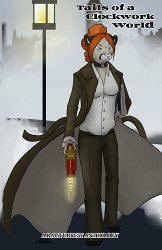Review: 'Tails of a Clockwork World'
 This second annual anthology of stories by and for the fans at Seattle’s annual RainFurrest convention had a theme of “Steam Punk, Weird Science/mad science”. Authors were requested to write a G to PG story of 5,000 to 8,000 words with a first deadline of February 2012, for revision and publication in time for the convention on September 27–30. The result is this neat little booklet published by FurPlanet Productions.
This second annual anthology of stories by and for the fans at Seattle’s annual RainFurrest convention had a theme of “Steam Punk, Weird Science/mad science”. Authors were requested to write a G to PG story of 5,000 to 8,000 words with a first deadline of February 2012, for revision and publication in time for the convention on September 27–30. The result is this neat little booklet published by FurPlanet Productions.
As before,
This Anthology was created and written by the fans of Rainfurrest. All the writers and artists have waived all fees, so that all the money will go to charity, so that our furry friends can have a better life. We want to thank all the writers involved, the artists and their brilliant images, and for FurPlanet for helping us put this together. This is a dream come true, and we hope to be able to continue this unique tradition.
(The charity of Rainfurrest 2012 was Rabbit Meadows, a Seattle-area rodent [and presumably lagomorphs] rescue society and clinic.)
“Tails of a Clockwork World: A Rainfurrest Anthology”.
Dallas, TX, FurPlanet Productions, September 2012, trade paperback $10.00 (119 pages).
The anthology has grown a bit since last year’s “Stories of Camp RainFurrest”. It is 119 pages vs. last year’s 108 pages. It is divided among only eight stories as opposed to last year’s eleven, so the stories have more depth. Four of these have full-page illustrations. So is it better or not? Well, it starts off encouragingly …
In “Wings” by Cary Kawamoto, a cat inventor is imprisoned for trying to make it possible for mammals to fly in a world ruled by geese, eagles, and other birds in dirigible airships. Kawamoto does a good job of describing the stately luxury dirigibles sailing through the skies, and the lone cat with his mechanical individual flying harness who would challenge this monopoly.
“One Night in Nocturnia” by Mary E. Lowd is told by a mouse inventor who creates a device to exchange minds. He makes arrangements to imprison his body, then trades minds with an owl, the mice’s age-old predator. He plans to go in the owl’s body into the owls’ homeland and wreak as much destruction as he can, but he does not expect the dazzling glory of Nocturnia, the complexity of its culture – the owls have trade relations with the bats -- or his feelings as an owl for a young she-owl.
She was a horrible vision, but beautiful nonetheless. (p. 19)
In “A Certain Point of View” by Hunter (identified as Garrett Biggerstaff, one of this book’s editors, on the story’s page headings), Seamus McCullough, a young Irish “bobtail” (terrier?) news-editor at a British radio station, gets a report from Lady Cecelia Concoulor’s missing expedition in the Bermuda Triangle, and must decide how much of it to reveal to the public. This story is almost too anthropomorphic, with a feline British noblewoman leading a ship of otters, tigers, and “rodentine crewmen”, canine Americans, equine Frenchmen, Inuit wolverines, Atlantean whales with purple-lightning-blasting tridents riding giant seahorses, and HUGE SQUID! It is also difficult to read, thanks to the author’s spelling out of the various accents: 
I’s mostly typin’ errors ‘n stuff, Morty my man.
I might be American, you walking fish fry, but we know better than to insult a lady. Lady Concolour came in peace and you better behave yourself before I send you back Cajun blackened!
This not your home is. Not are welcome here, land-dwellers. The People warning send you.
Aye Misseh! Ye heard th’ lady! Thunderguns for all crew! Get yer arses ‘n gear an’ let’s show these blasted fishmen not t’ toss with’er Majesty’s finest!
Great Fang-Colonel’s cloth had odd smell, Little Fang. Odd smell comes from this place. Nahak tracked whales once for month before he brought his people to catch. Nahak is sure.
And when Hunter is not making the reader plow through different accents, his normal prolix prose is not easy-going, either.
Not just one, but two giant bloody squid. Who on God’s green earth has ever seen, let alone lived to talk about a titanic piece of blasted calamari you’d get from one of the corner Italian or Spanish places where the owners don’t bother with a lick of the King’s English?! (p. 39)
In “Today is the Day I Destroy the Universe” by John Kupierz,
Angus traced his thick hoofhands over the schematics of the doomsday device for the dozenth time today, doing his best not to chew cud to calm himself. (p. 50)
Angus McBull, a Genius Anthrope of the bovine persuasion, along with Felicia Concolor, an uplifted puma, and Jason, a renegade human Mad Scientist (Angus’ homosexual lover and officially their owner), are threatening to destroy the human-dominated universe with their device if the British government will not grant the non-humans legal equality. If the government does not take this threat seriously, perhaps it is because of all the other doomsday devices created by rival Mad Scientists; or the Geniuses themselves.
His words were cut off as a lank-haired, begoggled Genius screamed above him in manic glee as more arcs of lightning fired into the room. ‘They’re resisting arrest! We had to kill them on the spot, isn’t that right?’ With a mad cackle, he … (p. 53)
But destroying the universe does not mean what you probably think that it means.
“Chance Encounters” by Ryan Hickey, the anthology’s other editor, is narrated by Miss Amanda Tudor, a black panther who was a nurse in the Great War and is now a newspaper owner in San Francisco. She is walking alone in one of San Francisco’s notoriously thick fogs when she becomes mixed into a battle between Arty, a bobcat, and …
… the Thing that lumbered into the street was … had been … a Panda, the left side of the body still had the fine white and black fur, thougt [sic.] faded with a few bald patches, but the right side was something altogether different. The right side of the poor man’s head seemed to have been replaced with a brass pot with rivets, a section cut out where the eye should have been replaced with a glowing red orb that burned like a coal from the fire in my study, the jaw was likewise made of brass ending in a jaw and mouth more fitted to one of those hunting traps still used up north for big game … (p. 71)
… etc. at considerably more length. The Thing is a Clockwork Corpse, so named not because it is mostly clockwork but because it was made by the evil scientist Baron von Clockwork. This story comes close to being unreadable because of a sudden plethora of typographical errors (on the first page alone: bradding for braiding, Jagua for Jaguar, mnne for mane, yourecoat for your coat, and numerous missing commas; p. 67) combined with ghodawful dialogue (“‘Like I said Baron it’s just me in here, that women was too terrified. She ran off leaving me all alone.’ Arty said with a grimace of pain locked on his muzzle.” p. 82; and “‘No thanks, I don’t think I want to join your little band of doomed misfit toys, but thank you any way for the offer, you deranged no-neck wackadoo.’ Said Arty.” p. 83)
“The Hunter and the Carnivorous Coniferous” by Ryan ‘Rufus’ Sirine sets Rufus LeVanque (lion?) and Alfred Tokingham (otter), two British young shippers(?), to escort Lady VanDort (panther) from Portland, Oregon where refugees from Seattle have gathered, back to the deserted city to find out what happened.
‘Seattle, as far as our information suggests, is completely deserted. A large number of people have died, or gone missing. The only clue we have is one partial telegraph message, which said ‘these trees are killing us all.’’ (p. 91)
This story is coherent but leaves many questions unanswered. What is Rufus, with tawny fur and an auburn mane? What do Rufus and Tok do, that they own a dirigible airship and are requested by the British government to undertake risky missions? Why and how are the trees around Seattle killing people or transforming them into trees? What happens after this story’s cliffhanger ending? This reads like an excerpt from a longer story in progress.
“Mind in a Bottle” by Sorin is really a trifle that goes nowhere. Ty, the lab assistant to Dr. Carter (cougar), observes as the scientist experiments in secrecy and then shuts everything down unfinished before it can be discovered. ???
“The Artificer’s Apprentice”, also by Ryan ‘Rufus’ Sirine, shows the same problem. Jakob, a young hyena artificer’s apprentice, is extremely talented at making mechanical devices. When his younger brother Seth, falls deathly ill, Jakob invents increasingly complex machines to keep him alive, until his master protests that he has gone beyond reason and is turning Seth into a mechanical monster. But Jakob will do anything to keep Seth alive! This story also breaks off rather than ends, leaving the reader wanting to know what happens next.
The four full-page illustrations by Rhari (who also drew the cover), RoheinFox, Temrin, and Rachel Fujii, are all quite good.
So: three stories that are very enjoyable; one that is worth plowing through the exaggerated accents and purple prose for; one that is not recommended due to excessive typographical errors and wincingly bad dialogue; and three that feel annoyingly incomplete. The four readable stories and the artwork are worth $10.00, but just barely. The two stories by Ryan Sirine are well-written as far as they go; he should turn one or both into full novels.
About the author
Fred Patten — read stories — contact (login required)a retired former librarian from North Hollywood, California, interested in general anthropomorphics
Comments
Post new comment